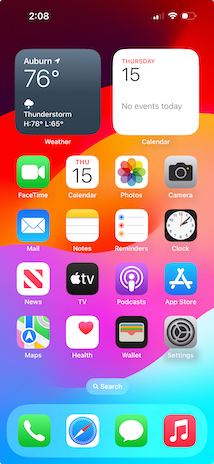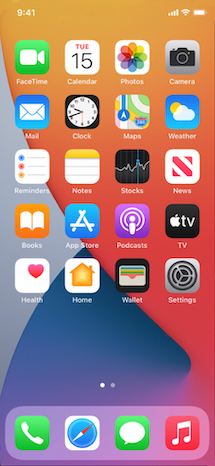Related Research Articles
Xcode is Apple's integrated development environment (IDE) for macOS, used to develop software for macOS, iOS, iPadOS, watchOS, tvOS, and visionOS. It was initially released in late 2003; the latest stable release is version 15, released on September 18, 2023, and is available free of charge via the Mac App Store and the Apple Developer website. Registered developers can also download preview releases and prior versions of the suite through the Apple Developer website. Xcode includes command-line tools that enable UNIX-style development via the Terminal app in macOS. They can also be downloaded and installed without the GUI.
Mobile app development is the act or process by which a mobile app is developed for one or more mobile devices, which can include personal digital assistants (PDA), enterprise digital assistants (EDA), or mobile phones. Such software applications are specifically designed to run on mobile devices, taking numerous hardware constraints into consideration. Common constraints include CPU architecture and speeds, available memory (RAM), limited data storage capacities, and considerable variation in displays and input methods. These applications can be pre-installed on phones during manufacturing or delivered as web applications, using server-side or client-side processing to provide an "application-like" experience within a web browser.

iOS is a mobile operating system developed by Apple Inc. exclusively for its smartphones. It was unveiled in January 2007 for the first-generation iPhone, launched in June 2007.
Cocoa Touch is the application development environment for building software programs to run on iOS for the iPhone and iPod Touch, iPadOS for the iPad, watchOS for the Apple Watch, and tvOS for the Apple TV, from Apple Inc.

The iOS SDK, formerly the iPhone SDK, is a software development kit (SDK) developed by Apple Inc. The kit allows for the development of mobile apps on Apple's iOS and iPadOS operating systems.
Titanium SDK is an open-source framework that allows the creation of native mobile applications on platforms iOS and Android from a single JavaScript codebase. It is presently developed by non-profit software foundation TiDev, Inc.
Vuforia is an augmented reality software development kit (SDK) for mobile devices that enables the creation of augmented reality applications. It uses computer vision technology to recognize and track planar images and 3D objects in real time. This image registration capability enables developers to position and orient virtual objects, such as 3D models and other media, in relation to real world objects when they are viewed through the camera of a mobile device. The virtual object then tracks the position and orientation of the image in real-time so that the viewer's perspective on the object corresponds with the perspective on the target. It thus appears that the virtual object is a part of the real-world scene.
Metaio GmbH was a privately held augmented reality (AR) company that was acquired by Apple Inc. in May of 2015. Headquartered in Munich, Germany, with subsidiaries in San Francisco, California, New York City, New York and Dallas, Texas, Metaio provided a software development kit (SDK) for programming PC, web, mobile application and custom offline augmented reality applications. Additionally, Metaio was the creator of Junaio, a free mobile AR browser available for Android and iOS devices.
TestFlight is an online service for over-the-air installation and testing of mobile applications, currently owned by Apple Inc. and only offered to developers within the iOS Developer Program. Developers sign up with the service to distribute applications to internal or external beta testers, who can subsequently send feedback about the application to developers. The TestFlight SDK additionally allows developers to receive remote logs, crash reports and tester feedback.

tvOS is an operating system developed by Apple Inc. for the Apple TV, a digital media player. In the first-generation Apple TV, Apple TV Software was based on Mac OS X. Starting with the second-generation, it is based on the iOS operating system and has many similar frameworks, technologies, and concepts.

Patrick Piemonte is an American inventor, computer scientist and user interface designer best known for his contributions to the iPhone and iPad at Apple, for which he has received over 180 patents.

iOS 11 is the eleventh major release of the iOS mobile operating system developed by Apple Inc., being the successor to iOS 10. It was announced at the company's Worldwide Developers Conference on June 5, 2017, and was released on September 19, 2017. It was succeeded by iOS 12 on September 17, 2018.

Tenor, Inc. is an online GIF search engine and database owned by Google. Its main product is the GIF Keyboard, which is available on Android, iOS, and macOS.
Swift Playgrounds is an educational tool and development environment for the Swift programming language developed by Apple Inc., initially announced at the WWDC 2016 conference. It was introduced as an iPad application alongside iOS 10, with a macOS version introduced in February 2020. It is available for free via Apple's App Store for iPadOS and Mac App Store for macOS.

iOS 13 is the thirteenth major release of the iOS mobile operating system developed by Apple Inc. for the iPhone, iPod Touch and HomePod. The successor to iOS 12, it was announced at the company's Worldwide Developers Conference (WWDC) on June 3, 2019, and released on September 19, 2019. It was succeeded by iOS 14, released on September 16, 2020.

iOS 14 is the fourteenth major release of the iOS mobile operating system developed by Apple Inc. for the iPhone and iPod touch lines. Announced at the company's Worldwide Developers Conference on June 22, 2020 as the successor to iOS 13, it was released to the public on September 16, 2020. It was succeeded by iOS 15 on September 20, 2021.

iOS 15 is the fifteenth major release of the iOS mobile operating system developed by Apple for its iPhone and iPod Touch lines of products. It was announced at the company's Worldwide Developers Conference on June 7, 2021, as the successor to iOS 14 and released to the public on September 20, 2021.
SwiftUI is a user interface framework for building user interfaces for iOS, iPadOS, watchOS, tvOS, visionOS and macOS, developed by Apple Inc. for the Swift programming language.

Apple Vision Pro is a mixed-reality headset developed by Apple Inc. It was announced on June 5, 2023, at Apple's Worldwide Developers Conference, and pre-orders began on January 19, 2024. It became available for purchase on February 2, 2024, in the United States. A worldwide launch has yet to be scheduled. The Vision Pro is Apple's first new major product category since the release of the Apple Watch in 2015.

visionOS is a mixed reality operating system derived primarily from iOS core frameworks, and MR-specific frameworks for foveated rendering and real-time interaction. It was developed by Apple Inc. exclusively for its Apple Vision Pro mixed reality headset. It was unveiled on June 5, 2023, at Apple's WWDC23 event alongside the reveal of the Apple Vision Pro. The software released on February 2, 2024, shipping with the Apple Vision Pro.
References
- ↑ Potuck, Michael (June 5, 2017). "Apple announces ARKit for iOS 11". 9to5Mac. Archived from the original on June 5, 2017. Retrieved June 5, 2017.
- ↑ Robertson, Adi (June 5, 2017). "Apple is launching an iOS 'ARKit' for augmented reality apps". The Verge . Vox Media. Archived from the original on June 5, 2017. Retrieved June 5, 2017.
- ↑ Smith, Chris (June 8, 2017). "One of the hottest iOS 11 features will force you to buy a new iPhone". BGR . Penske Media Corporation. Archived from the original on June 8, 2017. Retrieved June 10, 2017.
- ↑ "Bringing your ARKit app to visionOS". Apple Developer Documentation. Retrieved 2024-02-22.
- ↑ "ARKit in visionOS". Apple Developer Documentation. Retrieved 2024-02-22.